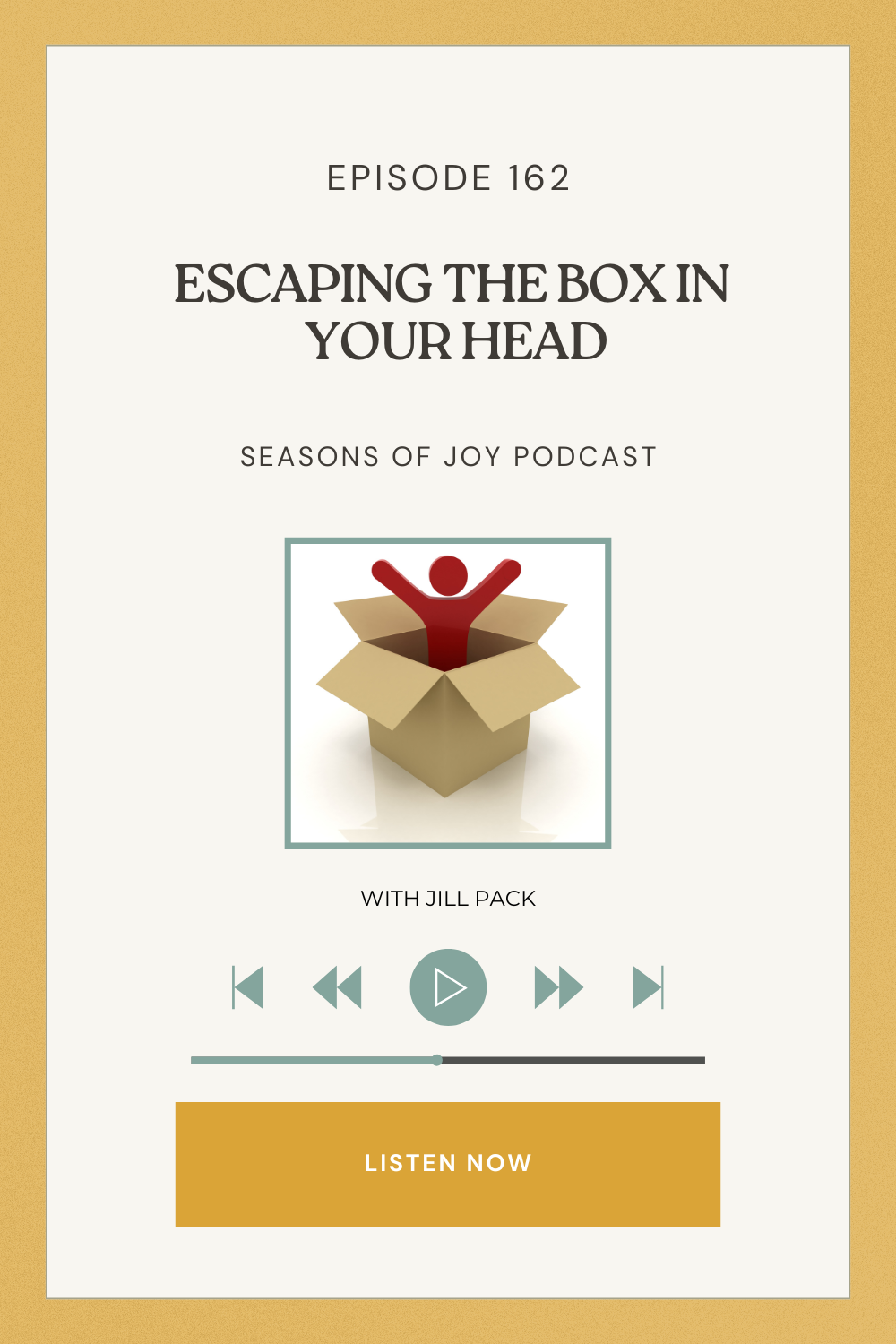Episode 162 - Escaping the Box in Your Head
Transform your relationships by recognizing when you're trapped in mental patterns of justification and blame
What Is "The Box" and Why Does It Matter?
Have you ever found yourself building a mental case against someone—listing all their flaws, justifying your frustration, and feeling completely right about your position? What if that very mindset is actually trapping you in a prison of your own making?
The concept of being "in the box" versus "out of the box" comes from the Arbinger Institute's groundbreaking books Leadership and Self-Deception and The Anatomy of Peace. But this isn't about creative thinking—it's about self-deception and how we distort our view of others to justify our own behavior.
Understanding Self-Deception: The Anatomy of the Box
Self-deception works in a predictable pattern:
The Initial Sense: You have a feeling that you should do something for another person—help them, listen, apologize, or have a difficult conversation.
The Betrayal: You choose not to act on that sense, betraying what you know or believe to be right.
The Justification: Since you've acted against your own sense of what's right, you need to justify it to yourself.
The Distortion: You begin seeing the other person in ways that make your choice seem reasonable—they become lazy, demanding, incompetent, or unreasonable in your mind.
When this happens, you've placed yourself "in the box," where you start seeing others as objects rather than people, and you become more focused on being right than solving problems.
Real-Life Examples: Recognizing the Box in Action
In Marriage
Scenario: You notice your spouse looks exhausted after a long day, and you feel you should help with dinner cleanup.
The Betrayal: You stay on the couch scrolling your phone instead.
In-the-Box Thinking:
"I worked hard today too"
"They always expect me to just jump in"
"They're being dramatic about being tired"
"I did the dishes yesterday"
The Result: Your spouse becomes "demanding and never appreciative" in your mind instead of a tired person who could use support.
Out-of-the-Box Alternative: You act on that initial feeling, get up and help, seeing your spouse as a partner who's had a rough day and deserves support.
With Adult Children
Scenario: Your adult child shares their career struggles, and you feel you should just listen supportively.
The Betrayal: You immediately jump into advice mode or criticism about their choices.
In-the-Box Thinking:
"They make poor choices"
"They're not realistic about life"
"They expect us to bail them out"
"They don't appreciate our wisdom"
The Result: Your child becomes "irresponsible and entitled" instead of a young adult trying to figure out their path.
With Aging Parents
Scenario: You feel like you should call your aging parent more often.
The Betrayal: You let weeks go by without meaningful contact.
In-the-Box Thinking:
"They guilt trip me when I call"
"They repeat the same stories"
"They don't understand how busy I am"
"They have other people they could call"
The Result: Your parent becomes "demanding and guilt-inducing" instead of someone who misses connection with their child.
Warning Signs: How to Know You're in the Box
Ask yourself these diagnostic questions:
Am I blaming someone else for this problem?
Am I making excuses for my own behavior?
Am I focusing on what's wrong with the other person?
Do I feel like a victim in this situation?
Am I more concerned with being right than finding a solution?
If you answered "yes" to any of these, you're likely in the box.
Emotional Indicators
In the Box: You feel frustrated, justified, defensive, or superior—looking down at people.
Out of the Box: You feel open, curious, compassionate, solution-focused, and humble.
Breaking Free: How to Get Out of the Box
Key Truths to Understand
You can't get out of the box by trying harder to be right—this only keeps you trapped.
You can't change other people when you're inside the box—but you can influence them when you're outside it.
The only way out is to stop justifying why you're inside the box—as long as you're justifying, you'll stay trapped.
The Four-Step Process
Stop and Notice: Ask yourself, "Am I in the box right now?" Pay attention to how you feel and use the diagnostic questions.
See the Person: Stop viewing them as an obstacle or problem to be solved. Start seeing them as a human being who might be struggling.
Take Responsibility: Focus on what you have control over—your own behavior. Stop justifying and start taking accountability for your choices.
Act on Authentic Impulses: When you feel like you should help, listen, apologize, or have a conversation, just do it.
The Ripple Effect: What Happens When You Get Out
The beautiful thing about escaping the box is the ripple effect it creates:
When you get out of the box, others often follow
Relationships improve without you trying to fix the other person
Problems get solved faster when you're not focused on winning or being right
Your 24-Hour Challenge
Pick one relationship that's been difficult for you lately and focus on getting yourself out of the box. Ask yourself:
How have I been in the box with this person?
How can I begin seeing them as a person rather than a problem?
What authentic impulse have I been ignoring?
Stop trying to change them, blame them, or justify why you're in the box. Instead, take responsibility for yourself and notice what happens when you begin seeing people as people.
The Bottom Line
Self-deception is normal and universal—we all do it as part of being human. The goal isn't perfection; it's awareness. Your boxes aren't about the other people in your life; they're about how you're viewing them.
Small shifts in perspective can create big changes in your relationships. You have more power than you think, but only when you're outside of the box.
Remember: it's not about never getting in the box again—it's about recognizing when you're there and knowing how to get out. With practice, this awareness becomes a muscle that strengthens over time, leading to more authentic, meaningful relationships with everyone in your life.
Subscribe to never miss an episode:
Join My Conversation Project
I'm currently seeking midlife women of faith for meaningful one-on-one conversations about your unique experiences during this important life season. These 30-minute private Zoom calls provide a safe space for you to share your authentic journey—both struggles and strengths—with deep listening and no judgment.
To participate, email me at jill@seasons-coaching.com with the subject line "Conversation Project."
Learn more about it HERE.
Want More Clarity?
Are you ready to take it to a deeper level? Jill would love to be your coach!
Click HERE to learn about all the ways you can work together!
Click HERE to schedule a FREE Clarity Conversation with Jill.
Click HERE to check out her FREEBIES!
Click on the following links to learn more about Seasons Coaching and the Seasons of Joy Community Facebook Group.
To contact Jill about speaking to your group or business, email her at jill@seasons-coaching.com.
Don’t forget to subscribe to the podcast and rate and leave a review! Help spread these tools!
About the Author: Jill Pack is a certified faith-based life + relationship coach and member of the Church of Jesus Christ of Latter-day Saints. She helps women of faith navigate their seasons of life with greater purpose and joy including transforming conflict into an adventure. For more resources or to work with Jill, visit www.seasons-coaching.com.

